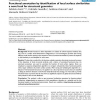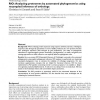221 search results - page 9 / 45 » Automated genome sequence analysis and annotation |
BMCBI
2006
13 years 7 months ago
2006
Background: Orthologs (genes that have diverged after a speciation event) tend to have similar function, and so their prediction has become an important component of comparative g...
BMCBI
2005
13 years 7 months ago
2005
Background: Protein function is often dependent on subsets of solvent-exposed residues that may exist in a similar three-dimensional configuration in non homologous proteins thus ...
CIA
2001
Springer
14 years 5 days ago
2001
Springer
The explosive growth in genomic (and soon, expression and proteomic) data, exemplified by the Human Genome Project, is a fertile domain for the application of multi-agent informat...
BMCBI
2007
13 years 7 months ago
2007
Background: Completion of the human genome sequence along with other species allows for greater understanding of the biochemical mechanisms and processes that govern healthy as we...
BMCBI
2002
13 years 7 months ago
2002
Background: When analyzing protein sequences using sequence similarity searches, orthologous sequences (that diverged by speciation) are more reliable predictors of a new protein&...


